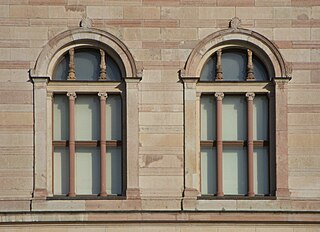 W
WA wall is a structure and a surface that defines an area; carries a load; provides security, shelter, or soundproofing; or, is decorative. There are many kinds of walls, including:Walls in buildings that form a fundamental part of the superstructure or separate interior rooms, sometimes for fire safety Glass walls Border barriers between countries Brick walls Defensive walls in fortifications Permanent, solid fences Retaining walls, which hold back dirt, stone, water, or noise sound Stone walls Walls that protect from oceans (seawalls) or rivers (levees)
 W
WSee List of fortifications for a list of notable fortified structures. For city walls in particular, see List of cities with defensive walls.
 W
WThe Anastasian Wall or the Long Walls of Thrace is an ancient stone and turf fortification located 64 km (40 mi) west of Istanbul, Turkey, built by the Eastern Roman Empire during the late 5th century.
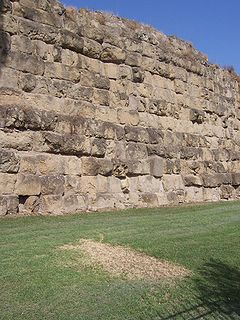 W
WDefensive walls are a feature of ancient Roman architecture. The Romans generally fortified cities, rather than building stand-alone fortresses, but there are some fortified camps, such as the Saxon Shore forts like Porchester Castle in England. City walls were already significant in Etruscan architecture, and in the struggle for control of Italy under the early Republic many more were built, using different techniques. These included tightly-fitting massive irregular polygonal blocks, shaped to fit exactly in a way reminiscent of later Inca work. The Romans called a simple rampart wall an agger; at this date great height was not necessary. The Servian Wall around Rome was an ambitious project of the early 4th century BC. The wall was up to 10 metres (32.8 ft) in height in places, 3.6 metres (12 ft) wide at its base, 11 km (7 mi) long, and is believed to have had 16 main gates, though many of these are mentioned only from writings, with no other known remains. Some of it had a fossa or ditch in front, and an agger behind, and it was enough to deter Hannibal. Later the Aurelian Wall replaced it, enclosing an expanded city, and using more sophisticated designs, with small forts at intervals.
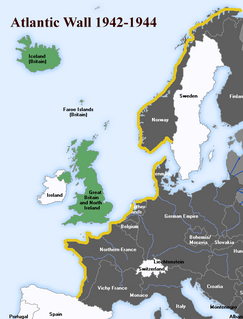 W
WThe Atlantic Wall was an extensive system of coastal defences and fortifications built by Nazi Germany between 1942 and 1944, along the coast of continental Europe and Scandinavia as a defence against an anticipated Allied invasion of Nazi-occupied Europe from the United Kingdom, during World War II. The manning and operation of the Atlantic Wall was administratively overseen by the German Army, with some support from Luftwaffe ground forces. The Kriegsmarine maintained a separate coastal defence network, organised into a number of sea defence zones.
 W
WThe Bayers Lake Mystery Walls are a series of stone structures and walls of unknown origin and uncertain age in Halifax, Nova Scotia.
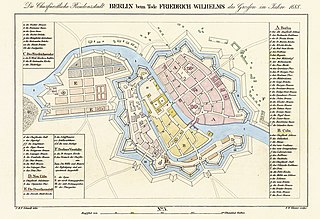 W
WThe Berlin Fortress was the fortification of the historic city of Berlin. Construction started in 1650. The demolition of its ramparts began in 1740.
 W
WCheolli Jangseong in Korean history usually refers to the 11th-century northern defense structure built during the Goryeo dynasty in present-day North Korea, though it also refers to a 7th-century network of military garrisons in present-day Northeast China, built by Goguryeo, one of the Three Kingdoms of Korea.
 W
WThe Communards’ Wall at the Père Lachaise cemetery is where, on May 28, 1871, one-hundred and forty-seven fédérés, combatants of the Paris Commune, were shot and thrown in an open trench at the foot of the wall.
 W
WCrown molding is a form of cornice created out of decorative molding installed atop an interior wall. It is also used atop doors, windows, pilasters and cabinets.
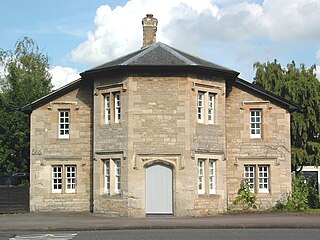 W
WCutteslowe is a suburb of north Oxford, England, between Sunnymead and Water Eaton.
 W
WDrystone Wall is a heritage-listed drystone wall at 2-4 Cleveland Terrace, Townsville CBD, City of Townsville, Queensland, Australia. It was built in 1877. It is also known as Queensland Transport, Townsville Library and School of Arts/Licence Testing Centre, and Townsville Supreme Court. It was added to the Queensland Heritage Register on 7 February 2005.
 W
WThe Fortifications of Derbent are one of the fortified defense lines built by the Persian Sasanian Empire to protect the eastern passage of the Caucasus Mountains against the attacks of the nomadic peoples of the Pontic–Caspian steppe. Built in the 6th century during the reign of Persian emperor Khosrow I and maintained by various later Arab, Turkish and Persian regimes, the fortifications comprise three distinct elements: the citadel of Naryn-Kala at Derbent, the twin long walls connecting it with the Caspian Sea in the east, and the "mountain wall" of Dagh-Bary, running from Derbent to the Caucasus foothills in the west. The immense wall, with a height of up to twenty meters and a thickness of about 10 feet, stretched for forty kilometers between the Caspian Sea and the Caucasus Mountains, thirty north-looking towers stretched for forty kilometers between the Caspian Sea and the Caucasus Mountains, effectively blocking the passage across the Caucasus. The fortification complex was made a UNESCO World Heritage Site in 2003.
 W
WThe Great Wall of China is a series of fortifications that were built across the historical northern borders of ancient Chinese states and Imperial China as protection against various nomadic groups from the Eurasian Steppe. Several walls were built from as early as the 7th century BC, with selective stretches later joined together by Qin Shi Huang (220–206 BC), the first emperor of China. Little of the Qin wall remains. Later on, many successive dynasties have built and maintained multiple stretches of border walls. The most well-known sections of the wall were built by the Ming dynasty (1368–1644).
 W
WHadrian's Wall, also known as the Roman Wall, Picts' Wall, or Vallum Hadriani in Latin, is a former defensive fortification of the Roman province of Britannia, begun in AD 122 in the reign of the emperor Hadrian. It ran from the banks of the River Tyne near the North Sea to the Solway Firth on the Irish Sea, and allowed the Roman Empire to project power some distance to the north, into the lands of the northern Ancient Britons, including the Picts.
 W
WThe Hexamilion wall was a defensive wall constructed across the Isthmus of Corinth, guarding the only land route onto the Peloponnese peninsula from mainland Greece.
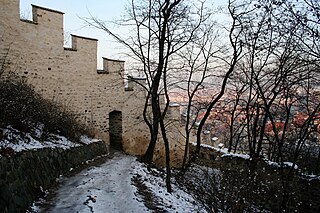 W
WThe Hunger Wall is a medieval defensive wall of the Lesser Town of Prague, today's Czech Republic. It was built on Petřín Hill between 1360 and 1362 by order of Charles IV.
 W
WThe Hushan or Tiger Mountain Great Wall, is a section of the Ming Great Wall in Kuandian Manchu Autonomous County, Liaoning, China. The wall runs for about 1,200 metres over Hushan.
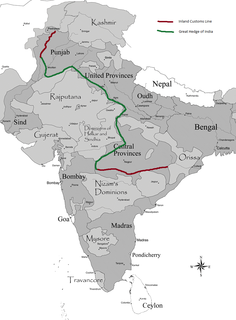 W
WThe Inland Customs Line which incorporated the Great Hedge of India was a customs barrier built by the British across India primarily to collect the salt tax. The customs line was begun while India was under the control of the East India Company but continued into the period of direct British rule. The line had its beginnings in a series of customs houses that were established in Bengal in 1803 to prevent the smuggling of salt to avoid the tax. These customs houses were eventually formed into a continuous barrier that was brought under the control of the Inland Customs Department in 1843.
 W
WThe Kingdom of Benin, was a kingdom in West Africa in what is now southern Nigeria. It is not to be confused with Benin, the modern-day nation-state. The Kingdom of Benin's capital was Edo, now known as Benin City in Edo state. The Benin Kingdom was "one of the oldest and most highly developed states in the coastal hinterland of West Africa". It was formed around the 11th century AD", and lasted until it was annexed by the British Empire in 1897.
 W
WThe Lennon Wall or John Lennon Wall is a wall in Prague, Czechia. Since the 1980s this once typical wall has been filled with John Lennon-inspired graffiti, lyrics from Beatles' songs, and designs relating to local and global causes.
 W
WLennon Wall, in the Hong Kong context, originally referred to the mosaic wall created during the Umbrella Movement, located at Central Government Complex, Harcourt Road, Admiralty. The wall is one of the major artworks of the Umbrella Movement as a collective artistic work of spontaneous free expression, demanding democracy in the elections of the territory's top leaders.
 W
WA Letzi or Letzimauer refers to defensive barriers whose purpose is to protect the entrance into a valley. The term is Swiss, and such stone barriers were particularly common in medieval Switzerland but were also built in Austria and Germany.
 W
WThe Little Western Wall, also known as HaKotel HaKatan, the Small Kotel,, and the Kleiner Koisel is a Jewish religious site located in the Muslim Quarter of the Old City of Jerusalem near the Iron Gate to the Temple Mount. The wall itself dates from the Second Temple period,. It is the continuation of the larger part of the Western Wall and almost exactly faces the Holy of Holies. HaKotel HaKatan is not as well-known and not as crowded as the larger part of the Western Wall. This section of the wall is of deep spiritual significance because of its close proximity to the Holy of Holies. However, it is not the closest location to the Holy of Holies, as there is a location in the Western Wall Tunnel which directly faces the Holy of Holies.
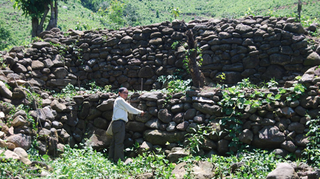 W
WThe Long Wall of Quang Ngai, Truong luy, or the Great Wall of Vietnam is a 127.4-kilometre (79.2 mi) rampart extending from Vietnam's Quảng Ngãi Province in the north to Binh Dinh Province in the south. The defensive wall was built by the Nguyen Dynasty as a demarcation line against the Đá Vách. It is the longest monument in Southeast Asia.
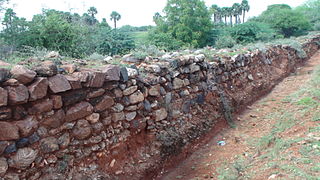 W
WThe Madukkarai Wall is a historic border fortification demarcating the boundaries of the three ancient kingdoms of Chera, Chola, and Pandya. The wall was supposedly erected by the goddess Sellandiyamman and may have been built as early as the 1st century AD.
 W
WThe Moroccan Western Sahara Wall or Berm is an approximately 2,700 km (1,700 mi) long structure, mostly a sand wall, running through Western Sahara and the southwestern portion of Morocco. It separates the Moroccan areas on the west from the Polisario-controlled areas on the east.
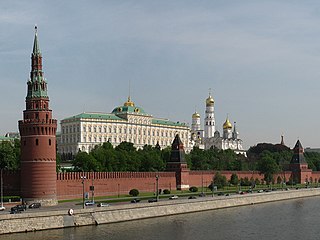 W
WThe Moscow Kremlin Wall is a defensive wall that surrounds the Moscow Kremlin, recognisable by the characteristic notches and its Kremlin towers. The original walls were likely a simple wooden fence with guard towers built in 1156. Kremlin walls, like many cathedrals in Kremlin were built by Italian architects. There are multiple walls with design of “swallow tail” in Verona.
 W
WA Nine-Dragon Wall or Nine-Dragon Screen is a type of screen wall with reliefs of nine different Chinese dragons. Such walls are typically found in imperial Chinese palaces and gardens.
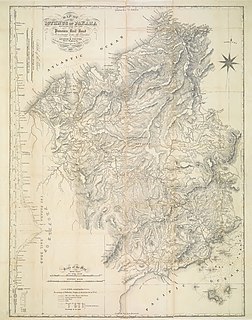 W
WMcPherson (2002) describes the controversial Panama Canal fence as a "separation barrier built by the United States in the Panama Canal Zone that divided the Republic of Panama in two separate sections". The Canal Zone, primarily consisting of the Panama Canal, was a strip of land running from the Pacific Ocean to the Caribbean. The fence, also called “Fence of Shame” and "another Berlin Wall” portrayed the centre of geopolitical and diplomatic turmoil between the United States and the Republic of Panama. Some evidences suggest construction, breaking and repairs of the fence while others including many aerial photographs and Life magazine confirm that there was no such physical barrier between the Canal Zone and Panama.
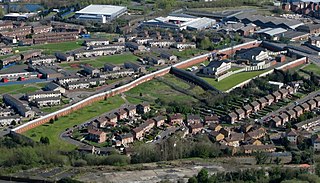 W
WThe peace lines or peace walls are a series of separation barriers in Northern Ireland that separate predominantly republican and nationalist Catholic neighbourhoods from predominantly loyalist and unionist Protestant neighbourhoods. They have been built at urban interface areas in Belfast, Derry, Portadown and elsewhere. The stated purpose of the peace lines is to minimise inter-communal violence between Catholics and Protestants.
 W
WThe Lavra fortification is a system of walls, towers and other constructions built for the protection of the Cave Monastery in Kyiv, the capital of Ukraine.
 W
WThe International Monument to the Reformation, usually known as the Reformation Wall, is a monument in Geneva, Switzerland. It honours many of the main individuals, events, and documents of the Protestant Reformation by depicting them in statues and bas-reliefs.
 W
WThe defense lines of the Sasanians were part of their military strategy and tactic. They were networks of fortifications, walls, and/or ditches built opposite the territory of the enemies. These defense lines are known from tradition and archaeological evidence.
 W
WSerpent's Wall is an ancient system of earthen earthworks (valla) located in the middle Dnieper Ukraine (Naddniprianshchyna) that stretch across primarily Kyiv Oblast, Ukraine. They seem to be similar in purpose and character to Trajan's Wall situated to the southwest in Bessarabia. The remaining ancient walls have a total length of 1,000 km and constitute less than 20% of the original wall system.
 W
WThe Southern Wall is a wall at the southern end of the Temple Mount and the former southern side of the Second Temple in Jerusalem. It was built during King Herod's expansion of the Temple Mount platform southward on to the Ophel.
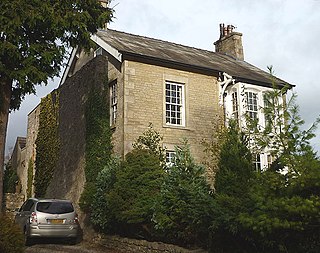 W
WSpite fence is a term used in property law in some countries to refer to an overly tall fence, structure in the nature of a fence, or a row of trees, bushes, or hedges, constructed or planted between adjacent lots by a property owner, who is annoyed with or wishes to annoy a neighbor, or who wishes to completely obstruct the view between lots. Several U.S. states and local governments have regulations to prohibit spite fences, or related regulations such as those establishing a maximum allowed height for fences. In the United Kingdom, the terms spite wall or blinder wall are more commonly used.
 W
WSungbo's Eredo is a system of defensive walls and ditches that is located to the southwest of the Yoruba town of Ijebu Ode in Ogun State, southwest Nigeria. It was built in 800-1000 AD in honour of the Ijebu noblewoman Oloye Bilikisu Sungbo. The location is on Nigeria's tentative list of potential UNESCO World Heritage Sites.
 W
WTegart's Wall was a barbed wire fence erected in May-June 1938 by British Mandatory authorities in the Upper Galilee near the northern border of the territory in order to keep militants from infiltrating from French-controlled Mandatory Lebanon and Syria to join the 1936–1939 Arab revolt in Palestine. With time the security system further included police forts, smaller pillbox-type fortified positions, and mounted police squads patrolling along it. It was described as an "ingenious solution for handling terrorism in Mandatory Palestine."
 W
WThe Tortilla Wall is a term given to a 14-mile section of United States border fence between the Otay Mesa Border Crossing in San Diego, California and the Pacific Ocean.
 W
WA trullo is a traditional Apulian dry stone hut with a conical roof. Their style of construction is specific to the Itria Valley, in the Murge area of the Italian region of Apulia. Trulli were generally constructed as temporary field shelters and storehouses or as permanent dwellings by small proprietors or agricultural labourers. In the town of Alberobello, in the province of Bari, whole districts contain dense concentrations of trulli. The golden age of trulli was the nineteenth century, especially its final decades, which were marked by the development of wine growing.
 W
WThe Tsoi Wall is a graffiti-covered wall in Moscow, dedicated to musician Viktor Tsoi and his band Kino. The wall is located at the house №37, at the intersection of Arbat Street and Krivoarbatsky Lane and is considered one of Moscow's landmarks. It is customary for Tsoi's fans to leave a broken lighted cigarette in the special ash plate by the wall.
 W
WThe Wall of Love is a love-themed wall of 40 square metres (430 sq ft) in the Jehan Rictus garden square in Montmartre, Paris, France. The wall was created in 2000 by calligraphist Fédéric Baron and mural artist Claire Kito and is composed of 612 tiles of enamelled lava, on which the phrase 'I love you' is featured 311 times in 250 languages. Each tile is 21 by 29.7 centimetres.
 W
W"Wall of Shame" is a phrase that is most commonly associated with the Berlin Wall. In this context, the phrase was coined by Willy Brandt, and it was used by the government of West Berlin, and later popularized in the English-speaking world and elsewhere from the beginning of the 1960s. Inspired by its usage in reference to the Berlin Wall, the term has later been used more widely.
 W
WThe Walls of Benin are a series of earthworks made up of banks and ditches, called Iya in the Edo language, in the area around present-day Benin City, the capital of present-day Edo, Nigeria. They consist of 15 km (9.3 mi) of city iya and an estimated 16,000 kilometres of rural iya in the area around Benin. The 'walls' of Benin City and surrounding areas were described as "the world's largest earthworks carried out prior to the mechanical era" by the Guinness book of Records. Some estimates suggest that the walls of Benin may have been constructed between the thirteenth and mid-fifteenth century CE and others suggest that the walls of Benin may have been constructed during the first millennium CE.
 W
WThe Wailing Wall or Western Wall, known in Islam as the Buraq Wall, is an ancient limestone wall in the Old City of Jerusalem. It is a relatively small segment of a far longer ancient retaining wall, known also in its entirety as the "Western Wall". The wall was originally erected as part of the expansion of the Second Jewish Temple begun by Herod the Great, which resulted in the encasement of the natural, steep hill known to Jews and Christians as the Temple Mount, in a huge rectangular structure topped by a flat platform, thus creating more space for the Temple itself, its auxiliary buildings, and crowds of worshipers and visitors.